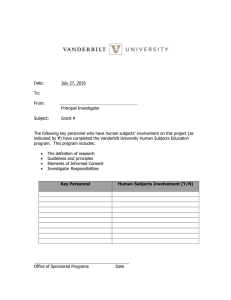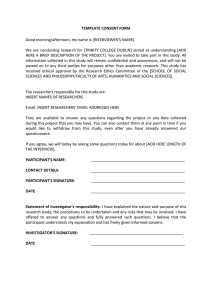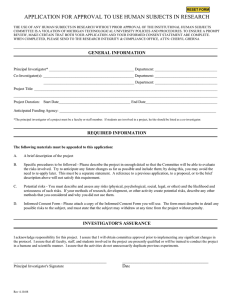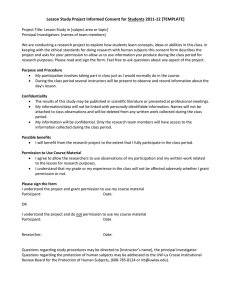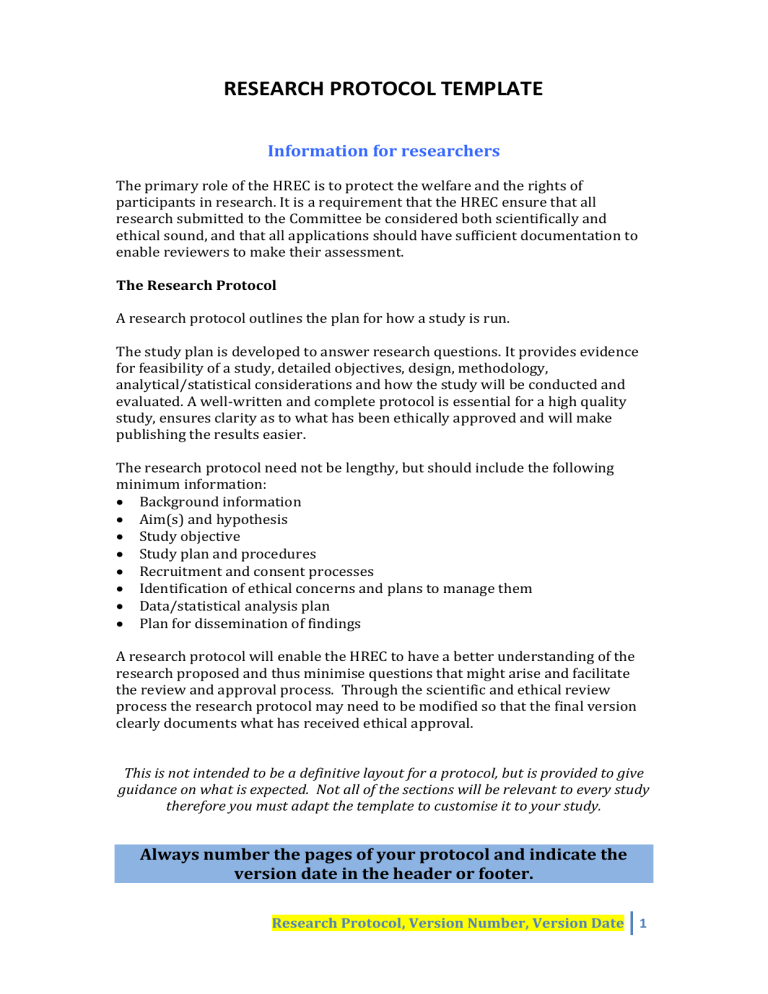
RESEARCH PROTOCOL TEMPLATE Information for researchers The primary role of the HREC is to protect the welfare and the rights of participants in research. It is a requirement that the HREC ensure that all research submitted to the Committee be considered both scientifically and ethical sound, and that all applications should have sufficient documentation to enable reviewers to make their assessment. The Research Protocol A research protocol outlines the plan for how a study is run. The study plan is developed to answer research questions. It provides evidence for feasibility of a study, detailed objectives, design, methodology, analytical/statistical considerations and how the study will be conducted and evaluated. A well-written and complete protocol is essential for a high quality study, ensures clarity as to what has been ethically approved and will make publishing the results easier. The research protocol need not be lengthy, but should include the following minimum information: Background information Aim(s) and hypothesis Study objective Study plan and procedures Recruitment and consent processes Identification of ethical concerns and plans to manage them Data/statistical analysis plan Plan for dissemination of findings A research protocol will enable the HREC to have a better understanding of the research proposed and thus minimise questions that might arise and facilitate the review and approval process. Through the scientific and ethical review process the research protocol may need to be modified so that the final version clearly documents what has received ethical approval. This is not intended to be a definitive layout for a protocol, but is provided to give guidance on what is expected. Not all of the sections will be relevant to every study therefore you must adapt the template to customise it to your study. Always number the pages of your protocol and indicate the version date in the header or footer. Research Protocol, Version Number, Version Date 1 1. STUDY TITLE Include lay title and acronym if appropriate. The title should be concise and clearly identify the focus of the research. 2. INVESTIGATORS Provide details of all investigators on the project. Investigator Name Contact Details Chief Investigator: Note, for student research the primary supervisor should be the Chief Investigator Role Responsibilities & tasks in this research project Relevant Qualifications Experience relevant to this project Expertise relevant to this project Investigator Name Contact Details Role e.g. Co-investigator/Student/Study co-odinator Responsibilities & tasks in this research project Relevant Qualifications 2 Research Protocol, Version Number, Version Date Experience relevant to this project Expertise relevant to this project Investigator Name Contact Details Role e.g. Co-investigator/Student/Study co-odinator Responsibilities & tasks in this research project Relevant Qualifications Experience relevant to this project Expertise relevant to this project Copy and paste additional copies of the table as needed. 3. AIMS Indicate broadly what the research hopes to achieve. 4. RESEARCH OBJECTIVES Provide a clear and concise statement of the primary objective and any secondary objectives. Your objectives need to: Concisely state exactly what you hope to achieve Be specific, attainable, measurable and realistic 5. TESTABLE HYPOTHESIS (if appropriate) Express each research question as a specific testable statement. Qualitative research studies are generally more exploratory and don’t have a hypothesis. Research Protocol, Version Number, Version Date 3 6. BACKGROUND AND RATIONALE Justification (identify knowledge gap or need, e.g. adding to knowledge, outputs, information to inform policy or practice); include relevance of the proposed participants and/or setting Briefly discuss existing information (relevant literature) and explain the research and choice of methods in this context; specify whether this research replicates prior work/duplicates other work/is original. If the research is part of a wider body of work, explain how it links to the wider inquiry 7. RESEARCH LOCATION Indicate where the research will take place. Specify the name of each site, the nature of the site, what activity will take place there, and who is responsible for the site. For example: UOW, academic unit, design and analysis, name of Chief Investigator Westfield Warrawong, shopping centre, recruitment and collection of survey data, name of co-investigator Site Name Type of site Involvement of site Lead Investigator for site 8. STUDY DESIGN 4 Details of research methods Details of the research population including any inclusion or exclusion criteria Details of the data collection setting Sample size, sample size calculation or justification of numbers. If more than one group is involved specify the number of groups and how many people in each group; if the study involves a randomised controlled trial provide details. If the study is a randomised controlled trial provide information on the process of randomisation and blinding, and the procedures for breaking the codes. Methods of assessment or measurement e.g. what questionnaires will you use and why are they the most appropriate? Include copies of all instruments/tools as attachments Outcome measures (baseline too) if applicable Intervention details (if appropriate) e.g. if giving a treatment specify dose, timing, method of delivery, potential risks, monitoring Details of any safety monitoring. What procedures will be used to monitor participant welfare and who will be responsible for identification, documentation and reporting of them? Who will review them (e.g. if it is a clinical trial will there be a Data Safety Monitoring Board?)? What are the stopping rules regarding efficacy and safety? Research Protocol, Version Number, Version Date Specify the data being collected and the form it will be collected in (e.g. audio recording, video recording) If accessing data collections, specify what collections and which data will be used If data linkage is involved, specify what is being linked and why Analysis – methods, by whom: include (as applicable) o Specify how data saturation will be achieved (qualitative research, if applicable) o Procedure for coding/categorising data (qualitative research) o Procedure for grouping, collating and statistically testing data relationships (quantitative research), specifying tests to be used o Identify potential sources of bias and how they will be managed Outline what will be involved for participants in all aspects of the study including the duration of each activity; if more than a single contact involved (e.g. an interview) include a flow chart Timeline 9. ETHICAL CONSIDERATIONS Ethical considerations are highly context specific; areas that should be considered and addressed where applicable include but are not limited to: Consider whether the project requires ethical or cultural approval by other bodies. If yes, name the other bodies and provide evidence of the permissions. Consider whether the project requires the researchers to be aware of, and use, culturally appropriate practices for any reason (national, social, professional). If yes, explain what they are and outline how this will be managed. Explain how ethical considerations will be reviewed as the study proceeds. Recruitment and selection of participants Provide details of where, when and how participants will be recruited, any screening process. Provide copies of all advertising material (fliers, posters) and scripts for any verbal information being provided. Specify and justify the inclusion and/or exclusion criteria Free and Informed consent Describe how voluntary informed consent will be sought and documented (who, where, when, how), including how time to think will be provided. If a waiver of consent is being sought justify this with reference to the relevant privacy legislation. Identify whether there could be any perception that people are obliged to take part (e.g. due to a dual relationship such as occurs when the researcher is a clinician and the participant their patient, or where the researcher is a teacher and the participant their student) and explain what is being done to minimise any perception of coercion. Include information about ability to withdraw and any limitations on this. If any payment or inducement will be offered provide details and comment on the possibility of this having a coercive affect on participants. If there will be any deception or withholding of information involved in the study provide details and justify this. Provide details of any debriefing that will be provided. Research Protocol, Version Number, Version Date 5 Risks, Burdens and Benefits What are the anticipated benefits of the research? Identify foreseeable risks or burdens for individuals, groups or society, including participants and researchers; include time commitments and physical and nonphysical harms (e.g. emotional upset, stress, risks to reputation, social status, insurability, criminal or civil liability). If there is a risk of disclosure of criminal activity that would necessitate mandatory reporting explain how this is being managed. Provide a justification for any risks and explain the steps that will be taken to minimise them. Justification is generally expressed in terms of potential benefits to individuals or the community. Explain the process for handling reports of adverse events and complaints. Confidentiality and Privacy Describe how confidentiality/anonymity/identity of participants will be maintained. Indicate whether identifying information will be collected or provided to researchers and a rationale for this. If data will be de-identified, coded and/or linked, provide details of the process. Potential Conflicts of Interest Consider whether there are any conflicts of interest resulting from the relationship of the researcher to the participant and if so, explain any safeguards to prevent this impacting on the research. Provide details of the expected cost of the project and the source of funding, including any financial interests in the outcome, and restrictions or reporting requirements. If a conflict of interest could impact on the research (e.g. dual relationship as above, or due to funding arrangements) explain how this is being managed. Dissemination of findings Provide details of how the research outcomes will be disseminated, not just to the scientific community but also to any relevant stakeholders, service users or policy makers. Examples of dissemination include media releases, reports to funders, academic publications. If participants will be co-owners of the outputs be clear about how the dissemination plan addresses their wishes. Explain how participants will be involved in dissemination/implementation of the research findings. If there will be a debriefing provide details. Data ownership and security, including storage and record retention What security steps are in place for collection, transfer, storage and destruction of data? This relates to where and how the data will be stored, and who will have access to it. If establishing a data collection for future use it is important to detail the proposed access arrangements. Ongoing use must be agreed to in the consent process. Consider ownership of the information, in terms of both where local and traditional knowledge are involved and where personal information is being collected. It is important that participants are clear about who will own the information and the outputs. What control, if any, will participants have over the information gained from or about them? 6 Research Protocol, Version Number, Version Date 10. REFERENCES Research Protocol, Version Number, Version Date 7
